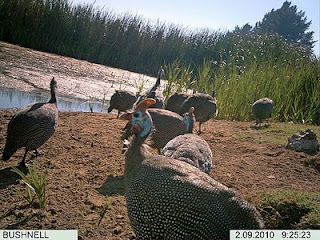Bontebok (Bontebok) are one of the more easily seen antelope at Tygerberg
I have been photographing a lot of Bontebok (Bontebok) recently and thought it's about time to look at them a little closer.
In the past
Bontebok (
Damaliscus pygargus pygargus) and
Blesbok (
Damaliscus pygargus phillipsi) were considered to be two separate species, but today both are considered
subspecies of the same species (
Damaliscus pygargus). In South Africa the two subspecies have been entrenched so deeply in our culture that they are often mentioned separately as Bontebok and Blesbok in literature and field guides (which usually only deal with species in detail).
The subspecies differ based on both color patterns and behavior. The color patterns alone are sufficient for identification in the field, if you know what to look for. Below is a summary of the differences between Bontebok and Blesbok:
- Color:
- Bontebok
- Body is a rich dark brown with a purple gloss.
- Blesbok
- Body is a reddish color with no purple gloss.
- Buttocks:
- Bontebok
- The area at the buttocks is pure white.
- Blesbok
- The area at the buttocks is generally not white but paler than the body.
- Limbs:
- Bontebok
- The limbs are white from the knee downwards, except for the brown stripes on the front of the forelimbs and sometimes a brown patch on the front of the hind limbs just above the hooves.
- Blesbok
- On the outer surface the forelimbs and hind limbs are dark brown.
- Horns:
- Bontebok
- The horns are usually black on the upper surface of the rings.
- Blesbok
- The horns are usually straw-colored on the upper surface of the rings.
The small herd arriving at the pond for a drink
It is commonly believed that the brown band separating the blaze (for Blesbok) on the face can be used for identification, but this is not 100% accurate and should rather not be used as the only means of identification. The pure white on the rump of the Bontebok is probably the best characteristic for distinguishing it from the Blesbok in the wild. In general the Bontebok appears to have more striking colors: it has a lot more white, the light areas are lighter and the dark areas are darker when compared with the Blesbok. The Bontebok also has a more noticeable "saddle" on its shoulders.
Hybridization can take place between the two subspecies and poses a genetic threat to both subspecies. The natural populations never lived in the same area and were separated by about 320km by the time of early settlement. Due to recent inbreeding and relocations both subspecies can be found outside their natural distribution ranges.
Chilling out...
The Bontebok is a medium sized antelope with a shoulder height of 90cm, weighing about 61kg. The white blaze on its face extends from the base of the horns to the nose, narrowing just above the eyes. Females are slightly smaller than males, but also have horns. Female horns are more slender and don’t thicken much at the base. The color of the males might be a little darker compared to the females. The fawns have a different color when they are young.
Youngster on his knees... I think he might be getting a little old for this kind of nonsense
The Bontebok is endemic to the Fynbos Biome and were historically confined to coastal plains with
Renosterveld vegetation.
The Bontebok is active during the day and lives in groups. As with many animals the greatest activity is in early mornings and late afternoon. During the hottest part of the day they rest in the open, but will use shade if it is available. Bontebok and Blesbok both tend to stand in groups on hot days and face the sun with their heads held low.
The pond is close to the fence, and although they are used to the houses sometimes somethings draw their attention
Male territory holders defecate on dung sites in their territory about 85% of the time and usually choose one when lying down. Bachelors and females defecate randomly. Serious fighting is rare and never results in injury.
They are almost exclusively a grazing subspecies and prefer short grass. They favor burnt areas and firebreaks for feeding. Access to water is essential.
Digging into some suculent green grass at the pond (It is the dry season at Tygerberg, because of the mostely Mediterranean climate of the Fynbos Biome)
There is a lot to be said about the conservation of the Bontebok. It was saved from extinction by a hand full of farming families. The Van Der Byl family set aside a portion of their farm near Bredasdorp in 1837 as a reserve for 27 Bonteboks. Other farmers (Van Breda and Albertyn) on neighboring farms followed this example and by 1931 the first Bontebok National Park was formed. The park was too small and a new bigger and more suitable park was established and stocked with 84 animals in 1960. By 1981 there were more than 300 animals and since then the surplus animals have been sold. Currently there are more than 2300 animals in South Africa many of which are on private land.
References:
John D. Skinner & Christian T. Chimimba (2005). The Mammals of the Southern African Subregion. Cape Town: Cambridge University Press. 653-655.

















